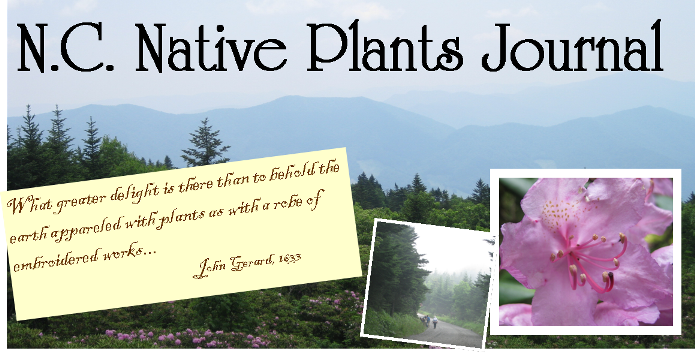Monday, April 12, 2010
North Carolina's Dandelions - native and introduced
The First Dandelion
Simple and fresh and fair from winter's close emerging,
As if no artifice of fashion, business, politics, had ever been,
Forth from its sunny nook of shelter'd grass--innocent, golden, calm as the dawn,
The spring's first dandelion shows its trustful face.
~Walt Whitman
One of my earliest memories involving plants is of dandelions, which are not native to this country. I remember pulling up a dandelion stem when the seed head was ripe, holding it in the direction of the wind, and making a fervent wish before blowing away the seeds. I don’t remember what I wished for, or if the wishes ever came true.
I am sure, however, that my father wished I would stop. He took great pride in his lawn, working hard to assure that it was lush, green, and weed free. I had no idea that my wishes were adding to his work, as the seeds fluttered around in abundance and dropped onto his lawn.
Dandelions germinate quickly, and at about a 90% rate. By the end of a season, it’s likely that a new plant from a seed is well established. Child’s play can keep herbicide and garden tool manufacturers happy (remember dandelion diggers?), if not lawn enthusiasts.
The name dandelion is derived from the Middle French dent de lion, or “lion’s tooth” because of the supposed similarity of the toothed leaves to a lions jaw. The Middle English had an interesting name for the plant, piss-a-bed, referring to its diuretic qualities.
They have been used for a wide variety of ailments, and are eaten raw, cooked, or the roots brewed as a beverage; from the flowers comes dandelion wine. The plants are higher in beta-carotene than carrots, and higher in iron and calcium than spinach. Our appetites, however, find them bitter. That can be remedied by cooking them in a couple of changes of water if you don’t enjoy the bitter flavor. Try a few fresh, raw leaves in your salad or on a sandwich along with lettuce for a sharp spicy flavor. Just be sure that any dandelion that you consume is herbicide and pesticide free, and does not grow near the roadside.
We have “dandelions” of our own, too, though to my knowledge they are not edible. There are about eight species of dwarf dandelion, known as Krigia, native to the U.S., five of which grow in North Carolina. Other than size and leaf shape, they look very much like the common lawn dandelion. Unlike the common plant, Krigia is not a lawn pest, and can be hard to find.
Twoflower dwarf dandelion, Krigia biflora, which has broad leaves, two or more flowers with no central disc, found mostly in the mountains.
Dwarf dandelion, Krigia caespitosa, has two flowers on each stem with multiple stems from each base.
Potato dwarf dandelion, Krigia dandelion, has narrow leaves with nodules on the roots that lead to the common name
Mountain dwarf dandelion, Krigia montana, usually has 1 flower and is restricted to mountain counties.
Virginia dwarf dandelion, Krigia virginica, is the smallest of our native dandelions, with a single flower atop each stem.
In Guilford and surrounding counties, you can find K. virginica, which grows almost every county in the state, and K. dandelion, which grows in most central NC counties. Virginia dwarf dandelion is an annual that would make a nice border plant if you could find a seed source. Since that is not likely, you will have to content yourself with looking closely at the dandelions you spot along the edges of woods, on creek banks, in meadows, or on granite outcrops.
Dandelions are not all alike, and our natives are attractive plants that support long-tongued bees (bumblebees, honeybees, little Carpenter bees, Mason bees), short-tongued bees, predatory wasps, flies, butterflies, skippers, and beetles. Deer do not seem to find them appealing.
Before you start yanking plants out of your lawn, make sure it is not a native dandelion. And while you are outside, there is one other child’s game you might want to try before you get out your dandelion digger: it is said that you can tell time with the seed heads…the number of puffs required to blow all the seeds free should tell you the time.
Photo from: Jeff McMillian @ USDA-NRCS PLANTS Database
http://www.usda.plants.gov/
Subscribe to:
Post Comments (Atom)






No comments:
Post a Comment
If you have comments or questions, you may post them here. You will have to register, so this blog avoids web-crawlers, but your address is NOT collected or used in any way.